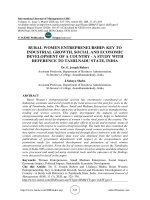Economic growth and economic development 552
Bạn đang xem bản rút gọn của tài liệu. Xem và tải ngay bản đầy đủ của tài liệu tại đây (79.83 KB, 1 trang )
Introduction to Modern Economic Growth
may have differential willingness to pay for quality, and thus the introduction of
a higher-quality DVD player is not the same as the production of a cheaper DVD
player. While issues of differential willingness to pay for quality are important in
industrial organization and for constructing accurate quality-adjusted price indices,
in most growth models, which typically represents the consumer side by a representative household, these issues do not arise and there is a close connection between
innovations that increase the quality of existing products and process innovations.
The following example illustrates why in the context of the models we use, quality
improvements can be viewed as process innovations.
Example 12.1. Consider an economy admitting a representative household with
preferences
U (c (q) , y | q) = u (qc (q)) + v (y) ,
where y stands for a generic good (perhaps representing all other goods), c is a
particular consumption goods available in different qualities. Here c (q) denotes the
amount consumed of the “vintage” of this good of quality q. The utility function
is also conditioned on q. This specification implies that higher-quality increases the
“effective units” of consumption. This is a typical assumption in growth models,
though it is clearly restrictive. The consumption (use) of five Pentium I computers
would not give the same services as the use of a single Pentium III computer. Let us
assume that both u (·) and v (·) are strictly increasing, continuously differentiable
and strictly concave functions.
Suppose also that the budget constraint of the consumer is
p (q) c (q) + y ≤ m,
where p (q) is the price of a good of quality q and the price of the generic good is
normalized to 1. The first-order condition of the individual implies that
qu0 (qc (q))
= p (q) .
v 0 (y)
It can be verified from this first-order condition that an x% increase in quality q
and an x% decline in the price p (q) have exactly the same effects on the effective
units of consumption and on welfare. This justifies the claim above that in many
538









